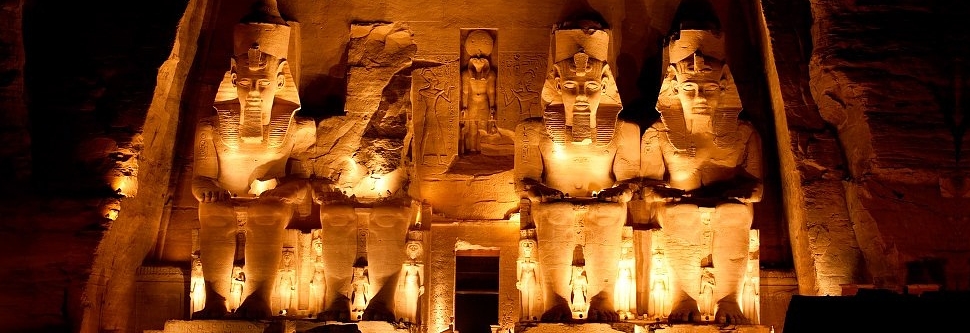
|
Home of the Rescued Temples The very small village of Abu-Simbel lies 280 km south of Aswan, and only 40 km north of the Sudanese border. Even though it is home to several hotels, the small town is usually overlooked by tourists as a holiday destination. Most of them prefer to visit the Nubian town on a daytrip from Cairo or Aswan or as an extension to a Nile cruise or a Lake Nasser Cruise. Perched atop a hill overlooking the Nile, the majestic Abu-Simbel temples are a UNESCO World Heritage Site. Dedicated to Ramses II & Nefertari, the world-famed temples will take your breath away. After a visit to this inspiring site, you can walk around the colourful touristic market, go bird watching on the lake Nasser and get back to the temples again in the evening for the amazingly inspiring sound & light show. Staying in Abu-Simbel for a night or two will allow you to enjoy the peace and magic of this Nubian town at your own pace and discover the true spirit of Abu-Simbel, gaze at the magnificent statues for hours and avoid the hordes of tourists arriving usually in the early morning. You’ll also get a glimpse of the hearty Nubian culture by listening to Nubian music, meeting with the locals, and maybe even escaping to the nearby desert for some more inspiring experiences. |
عرض abusimbel في خريطة أكبر |
|
 Nubia:  Nubia is located in today's southern Egypt and northern Sudan. The modern inhabitants of southern Egypt and Sudan still refer to themselves as Nubians. They speak the Nubian language as well as Arabic. Thousands of Nubians from the north were forced to relocate from their endangered homelands to be resettled in Egypt and Sudan. This land has one of the harshest climates in the world. The temperatures are high throughout most of the year, and rainfall is infrequent. The banks of the Nile are narrow in much of Nubia, making farming difficult. Yet, in antiquity, Nubia was a land of great natural wealth, of gold mines, ebony, ivory and incense which was always prized by her neighbors. Nubia is located in today's southern Egypt and northern Sudan. The modern inhabitants of southern Egypt and Sudan still refer to themselves as Nubians. They speak the Nubian language as well as Arabic. Thousands of Nubians from the north were forced to relocate from their endangered homelands to be resettled in Egypt and Sudan. This land has one of the harshest climates in the world. The temperatures are high throughout most of the year, and rainfall is infrequent. The banks of the Nile are narrow in much of Nubia, making farming difficult. Yet, in antiquity, Nubia was a land of great natural wealth, of gold mines, ebony, ivory and incense which was always prized by her neighbors.Nubia is the homeland of Africa's earliest black culture with a history which can be traced from 3100 BC onward through Nubian monuments and artifacts, as well as written records from Egypt and Rome. The land of Nubia is a desert divided by the river Nile. For want of water and rich soil, most of Nubia has never been able to support a large population for long periods. However, some of Africa's greatest civilizations emerged here, centers of achievement whose existence was based on industry and trade. Because they did not write their own languages until very late in ancient times, we know these centers and their people largely through their archaeology and what the Egyptians and Greeks said about them.  To the ancient Mediterranean world, the land south of Egypt was a territory of mystery and legend. Wealth and exotic products came from there. It was the home of the Ethiopians, whom Homer called blameless and stories about its great achievements endured to tantalize the modern world. This land is one of enormous distances, and its exploration was long impeded by problems of transport and political unrest. In the last hundred years, Nubia has slowly yielded its secrets, its vanished peoples, abandoned cities and lost kingdoms brought to light by the excavator and analysis of inscriptions. This exhibit is a selection of objects recovered over twenty years ago by the Oriental Institute Nubian Expedition in the effort to rescue archaeology from the rising water behind the Aswan Dam. To the ancient Mediterranean world, the land south of Egypt was a territory of mystery and legend. Wealth and exotic products came from there. It was the home of the Ethiopians, whom Homer called blameless and stories about its great achievements endured to tantalize the modern world. This land is one of enormous distances, and its exploration was long impeded by problems of transport and political unrest. In the last hundred years, Nubia has slowly yielded its secrets, its vanished peoples, abandoned cities and lost kingdoms brought to light by the excavator and analysis of inscriptions. This exhibit is a selection of objects recovered over twenty years ago by the Oriental Institute Nubian Expedition in the effort to rescue archaeology from the rising water behind the Aswan Dam.In the 1960's, a dam was constructed at Aswan, Egypt. It created a 500 mile long lake which permanently flooded ancient temples and tombs as well as hundreds of modern villages in Nubia. While the dam was under construction, hundreds of archaeologists worked in Egypt and Sudan to excavate as many ancient sites as possible. The Oriental Institute worked in Nubia from 1960 until 68. Today, the 5000 Nubian objects in the collection of The Oriental Institute Museum and thousands of objects in other museums are our sole resource for recovering the rich civilization of northern Nubia, for the sites themselves now lie beneath the waters of Lake Nasser. In contrast, expeditions from many countries are working in southern Nubia. | ||
|
|
|